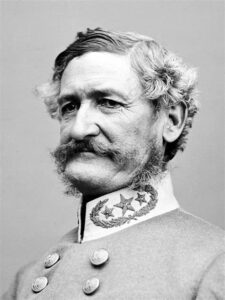
 When you think about the Civil War, you think of battles being fought back east…right? For the most part, it was. When the war began, there were 34 states, but by the end, there were 36 states. Of course, some of the Southern states, eleven to be exact, wanted to secede and form their own country. That was partly what the war was about. The Southern states wanted to keep slavery, and the Northern states did not, and because they could not agree, eleven states chose to secede, and the rest fought to keep our nation together.
When you think about the Civil War, you think of battles being fought back east…right? For the most part, it was. When the war began, there were 34 states, but by the end, there were 36 states. Of course, some of the Southern states, eleven to be exact, wanted to secede and form their own country. That was partly what the war was about. The Southern states wanted to keep slavery, and the Northern states did not, and because they could not agree, eleven states chose to secede, and the rest fought to keep our nation together.
Some of the battles were fought, however on the far western front. The first of those battles, was on February 21, 1862. In the Battle of Valverde, Confederate troops under General Henry Hopkins Sibley attacked Union troops commanded by Colonel Edward R S Canby near Fort Craig in the New Mexico Territory. This first major engagement of the Civil War in the far West, produced heavy casualties but ended with no decisive result. Of course, the battle was part of the broader movement by the Confederates to capture New Mexico and other parts of the West. The point was to secure territory that the Rebels thought was rightfully theirs, because it was part of the southern territories of the United States. This area had been denied them by political compromises made before the Civil War, which they felt was wrong. 

By this time, the Confederacy was quickly going broke, and they wanted to use Western mines to fill its treasury. The Rebel troops moved from San Antonio, into southern New Mexico, which at that time included Arizona, and captured the towns of Mesilla and Tucson. Sibley, with 3,000 troops, now moved north against the Federal stronghold at Fort Craig on the Rio Grande. Canby was determined to make sure the Confederates didn’t lay siege to Fort Craig. Canby knew that the Rebels were running low on supplies, and they wouldn’t last much longer. He knew that Sibley really did not have sufficiently heavy artillery to attack the fort, so when Sibley arrived near Fort Craig on February 15, he ordered his men to swing east of the fort, cross the Rio Grande, and capture the Valverde fords of the Rio Grande. He hoped to cut off Canby’s communication and force the Yankees out into the open, thereby giving the Rebels the upper hand.
For Sibley’s Rebels, things at the fords didn’t initially go as planned. Five miles north of Fort Craig, a Union detachment attacked part of the Confederate force. The Yankees pinned the Texan Rebels in a ravine and were on the verge of routing them when more of Sibley’s men arrived and turned the tide. Sibley’s second in command, Colonel Tom Green, who was filling in for Sibley, who was ill, made a bold counterattack against the Union left flank. The Yankees retreated, heading back to Fort Craig. Sibley’s men didn’t take Fort Craig either.
During the Battle of Valverde, out of 3,100 men, the Union suffered 68 killed, 160 wounded, and 35 missing. 
 The Confederates suffered 31 killed, 154 wounded, and 1 missing out of 2,600 troops. The battle was indeed bloody, but none of their objectives were accomplished, so it was virtually an indecisive battle. From Fort Craig, Sibley’s men continued up the Rio Grande winning battle after battle. Nevertheless, after capturing Albuquerque and Santa Fe, they were stopped at the Battle of Glorieta Pass on March 28, 1862.
The Confederates suffered 31 killed, 154 wounded, and 1 missing out of 2,600 troops. The battle was indeed bloody, but none of their objectives were accomplished, so it was virtually an indecisive battle. From Fort Craig, Sibley’s men continued up the Rio Grande winning battle after battle. Nevertheless, after capturing Albuquerque and Santa Fe, they were stopped at the Battle of Glorieta Pass on March 28, 1862.


Leave a Reply